The Amiiformes order of fish has only one extant species, the bowfin. These Amiiformes are found in the freshwater systems throughout North America and parts of southern Canada. They live in freshwater streams, rivers, and swamps. These bowfin fish are not on the endangered list. They have the ability to go to the surface to breathe if the water level is too low. The extinct species of the Amiiformes can be found fossilized in Asia and Europe, but the bowfin is the last living species in the order.

The Lamniformes are an order of sharks commonly known as mackerel sharks. It includes some of the most familiar species of sharks, such as the great white, as well as more unusual representatives, such as the goblin shark and megamouth shark.

Lates is a genus of lates perches belonging to the family Latidae. The generic name is also used as a common name, lates, for many of the species.

The Lamnidae are the family of mackerel or white sharks. They are large, fast-swimming sharks, found in oceans worldwide. The name of the family is formed from the Greek word, lamna, which means fish of prey, and was derived from the Greek legendary creature, the Lamia.

The Palaeonisciformes are an extinct order of early ray-finned fishes (Actinopterygii) which began in the Late Silurian and ended in the Late Cretaceous. The name of the order is derived from the Greek words paleo (ancient) and ὀνίσκος, probably pertaining to the organization of the fishes' scales, similar to the exoskeletal plating of woodlice.
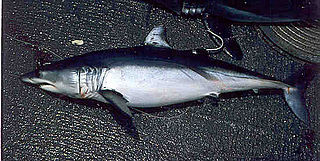
Isurus is a genus of mackerel sharks in the family Lamnidae, commonly known as the mako sharks.

Carcharias is a genus of sand tiger sharks belonging to the family Odontaspididae.
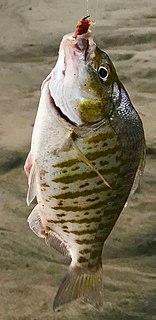
The barred surfperch is a species of surfperch native to inshore waters from northern California, United States to southern Baja California, Mexico. This species can reach a length of 43 centimetres (17 in) TL though most do not exceed 30 centimetres (12 in) TL. The maximum recorded weight is 2.0 kilograms (4.4 lb). Like other surfperches, it gives birth to live young. The diet of the barred surfperch consists predominantly of sand crabs .
According to the California Department of Fish and Game, Barred Surfperch can be identified by bars and spots on sides which are often unbarred, as well as the absence of red tail.
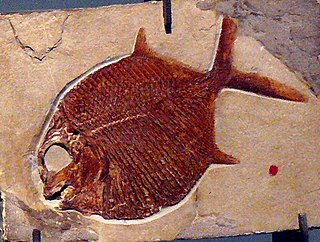
Pycnodontiformes is an extinct order of bony fish. The group evolved during the Late Triassic and disappeared during the Eocene. The group has been found in rock formations in Africa, Asia, Europe, North and South America.
Hyperprosopon ellipticum, the silver surfperch, is a species of surfperch native to the eastern Pacific Ocean. This species is also displayed in public aquariums.

Cidaridae is a family of sea urchins in the order Cidaroida.

Amphistichus is a genus of surfperches native to the eastern Pacific Ocean.
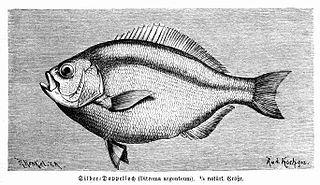
Hyperprosopon is a genus of surfperches native to the eastern Pacific Ocean.
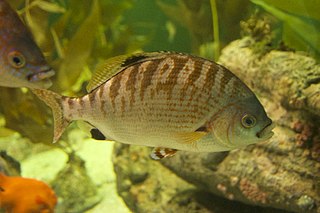
The rainbow surfperch or rainbow seaperch is a species of surfperch found along the Pacific coast of North America from Cape Mendocino, California to northern Baja California, Mexico. This species prefers rocky shores over sandy ones, and is never found in the surf, preferring the edges of kelp forests down to depths of about 40 metres (130 ft). This species grows to a length of 30 centimetres (12 in) TL. This species is the only known member of its genus. The specific name honours Thomas Cary (1824-1888), a business man and amateur naturalist who was also the brother-in-law of Louis Agassiz who procured specimens that confirmed that this species was viviparous.
Phanerodon is a genus of surfperches native to the eastern Pacific Ocean.
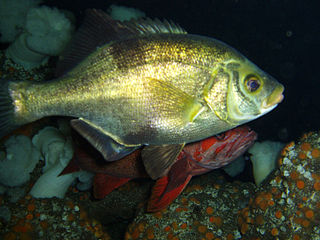
Rhacochilus is a genus of surfperches native to the eastern Pacific Ocean.
the pink surfperch, or pink seaperch, is a species of surfperch native to the eastern Pacific Ocean from Point Delgada, California, United States to southern Baja California and also in the Gulf of California. This species is an offshore member of the family occurring at depths of from 8 to 229 metres. This species grows to a length of 20 centimetres (7.9 in) TL. This species is the only known member of its genus.

Embiotoca jacksoni, commonly known as the black surfperch, is a species of surfperches native to shallow coastal areas of the Eastern Pacific. Other common names of the species include black perch and butterlips. They are usually a dark reddish brown to tan in color, often also with vertical dark bars across their body. They are commercially important food and game fish.

Embiotoca lateralis, commonly known as the striped surfperch or striped seaperch, is a species of surfperch native to the North Eastern Pacific Ocean.

Araeosoma is a genus of deep-sea sea urchins in the family Echinothuriidae.
















